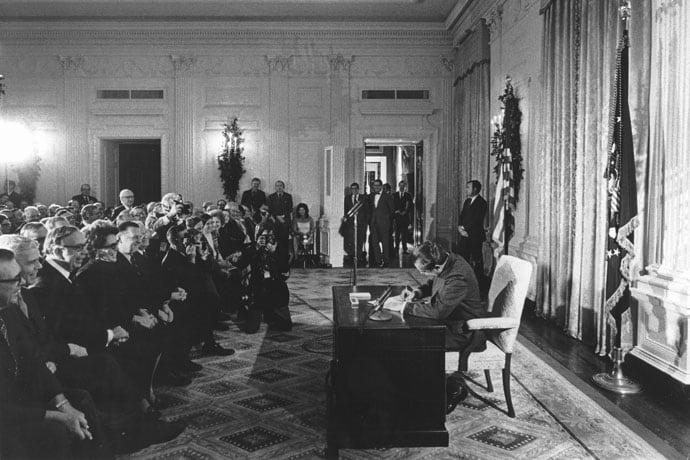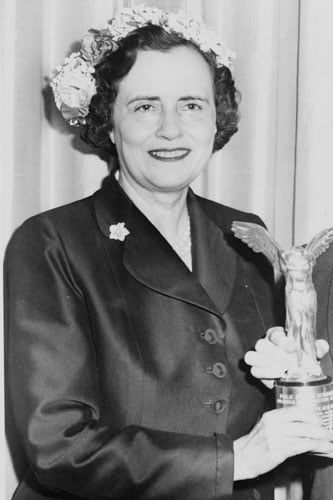The War on Cancer at 50

President Richard Nixon signs the National Cancer Act on December 23, 1971.
The roots of the National Cancer Act can be traced to a small home in Watertown, Wisconsin. In the early 1900s, a girl named Mary tagged along when her mother went to visit their laundress, Mrs. Belter, who had breast cancer.
When they arrived, the woman was in bed, her seven children around her. She was terribly sick. That day, Mary was only around 4 years old, but she remembered it for the rest of her life.
“When I stood in the room and saw this miserable sight, with her children crowding around her, I was absolutely infuriated, indignant that this woman should suffer so and that there should be no help for her,” she recalled decades later, in 1962.
That girl grew up to be Mary Lasker, who transformed her outrage into action. Lasker became an activist, philanthropist and strategist focused on supporting medical research.
Belter, who’d had her breasts removed, survived.
“I’ll never forget my anger at hearing about this disease that caused such suffering and mutilation and my thinking that something should be done about this,” Lasker recounted.
In the first half of the 20th century, cancer was misunderstood. It was widely considered a death sentence, and some people believed it was contagious and something to be ashamed of.
“It was a disease diagnosis that was whispered about and kept secret,” said Ned Sharpless, director of the National Cancer Institute. Sharpless said that to protect a person’s dignity, doctors commonly fibbed about someone’s condition or said that “the patient died of old age.”
Decades of advocacy — and scientific breakthroughs — have dramatically changed that. The U.S. government has spent more money on the fight against cancer than any other disease, and many cancers are far less deadly than they once were.
A crucial moment in this evolution was the president’s signing of the National Cancer Act into law 50 years ago, on Dec. 23, 1971.
Launching a Crusade
For years, Mrs. Belter’s illness remained vivid in Mary Lasker’s mind. About 40 years later, in 1943, her cook also fell ill with cancer. As Lasker — a person with wealth and status — helped her employee navigate the health care system, she was shocked to discover that cancer care had not advanced much.

Mary Lasker, the American health activist, presenting an award.
So Lasker started a crusade. In the 1940s, broadcasters wouldn’t say “cancer” on the radio. She worked to change that, with the help of her husband, Albert Lasker, an advertising executive. The couple persuaded Reader’s Digest to do a series of articles about cancer. And Lasker persuaded her friend behind the Ann Landers advice column to write about it.
Lasker, who died in 1994 at age 93, didn’t just focus on changing the popular perceptions of cancer. She wanted to cure cancer, and that demanded a real investment in medical research.
“The amount of money that’s being spent for medical research is … well, it’s just piddling,” Lasker told Edward R. Murrow on CBS in 1959. “You won’t believe this, but less is spent on cancer research than we spend on chewing gum.”
After the United States put a man on the moon, Lasker started calling for “a moonshot for cancer.”
“She understood that this was a big problem and the solutions needed to be big. But Mary was willing to think big,” said Dr. Claire Pomeroy, president of the Albert and Mary Lasker Foundation.
Lasker built her movement: lobbying Congress and making the most of her time on the social circuit. She was a frequent visitor to the White House, as a friend of President Lyndon Johnson and his wife, Lady Bird.
At the same time, new treatments were being pioneered only a few miles away, at the National Cancer Institute in Bethesda, Maryland. Dr. Robert Mayer was working there, just beginning his career in medicine.
“Every Sunday night, the planes would fly in with patients,” Mayer recalled.
Those patients were young children who had acute leukemia and were traveling to the National Institutes of Health to receive their monthly doses of chemotherapy. They came from all over the country because only a handful of hospitals were then capable of aggressively treating cancer patients.
“My colleagues thought we were a little crazy, that we would be giving people ‘cell poisons,’ which is what chemotherapy was thought to be,” said Mayer, now an oncologist at the Dana-Farber Cancer Institute in Boston and a professor at Harvard Medical School.
Chemotherapy was still experimental, but the doctors at the National Cancer Institute were getting results. For one pediatric leukemia, the chance of survival improved dramatically.
“It wasn’t just that they were people — they were children, and they were children at an adorable age of 3 or 4 or 5,” Mayer said.
As the stories of these surviving children trickled out in the 1960s, a sense of optimism took hold.
Persuading Congress to Go Big
By the late 1960s, Lasker felt things were moving too slowly and decided to increase the pressure on lawmakers by taking out targeted newspaper ads in key congressional districts.
“This absolutely shocked the people in the House because they never had ads before and people were calling up from their districts and sending telegrams, and it caused quite a little commotion,” Lasker said in an interview for the Oral History Research Office at Columbia University Libraries.
She also pestered President Richard Nixon, and publicly. She paid for full-page ads in The New York Times and The Washington Post. Big letters screamed out from the page: “Mr. Nixon: You can cure cancer.”
The decades-long campaign in research labs, in the halls of Congress, and in the media finally paid off. On Dec. 23, 1971 — at about noon — Nixon spoke to a crowd of over 100 people, including Mary Lasker, members of Congress, and prominent scientists and doctors.
“Hope and comfort, the relief of suffering and the affirmation of life itself — these are qualities which have traditionally been associated with the Christmas season,” Nixon said in a press statement. “There could be no more appropriate time than this to sign into law the National Cancer Act of 1971.”
After signing the bill, Nixon posed for the cameras, with members of Congress arranged behind his chair. Sen. Edward Kennedy of Massachusetts, the Democratic whip and chief sponsor of the bill in the Senate, stood directly behind the president, his hand on the back of the chair.
That moment reveals how support for medical research had become politicized, according to Robin Wolfe Scheffler, a historian of science at the Massachusetts Institute of Technology. In Scheffler’s analysis, Nixon signed the bill, in part, to ensure that his support for health research would not be in question during the 1972 presidential race. Kennedy was not seeking the nomination, officially, but was widely considered a possible front-runner.
“Nixon embraces the war on cancer as a way of taking an issue away from his potential future rivals, not necessarily because he has any particular desire to do something about cancer,” said Scheffler, author of “A Contagious Cause: The American Hunt for Cancer Viruses and the Rise of Molecular Medicine.”
Regardless of Nixon’s motivation, the public investment was significant, $1.6 billion (almost $11 billion in today’s dollars). The National Cancer Act funded biomedical research, set up oncology training programs and built a nationwide network of cancer treatment centers.
Many people thought the cancer moonshot would lead to a cure in five years, in time for the country’s bicentennial in 1976. But curing cancer would prove to be much harder than going to the moon.
“I think you have to admit two things about the National Cancer Act. On the one hand, it was visionary and transformative. It was one of the most important things the United States has ever done in terms of biomedical research,” Sharpless said. “At the same time, we also have to admit that it was very naive.”
America’s bicentennial came and went, but cancer death rates continued to climb. News anchors questioned whether taxpayers’ money was being wasted.
“People declared the war on cancer ‘a medical Vietnam,'” Scheffler said.
A debate ensued about whether the National Cancer Act’s focus on basic research was misguided if it wasn’t leading to advances in treatment. Environmental activists argued that the emphasis should have been on prevention.
It took time for the research investment to pay off, Sharpless said. “All this basic biology was bubbling beneath the surface. It doesn’t look like much was happening in terms of cancer outcomes,” he said. “But a lot was happening in the … cancer research space.”
Now, 50 years after the funds started flowing, “we really are in a time of rapid progress,” Sharpless said.
Although 600,000 Americans die from cancer each year, the overall death rate for cancer has dropped by about a third from its peak in 1991. But the progress has been uneven.
For some cancers, the prognosis is still bleak. For example, the vast majority of people diagnosed with pancreatic cancer die within a few years. But for other types of cancer, there have been major medical advances. Death rates for colorectal cancer, cervical cancer and prostate cancer have declined more than 50%. And there have been advances in the treatment of lung cancer, breast cancer and melanoma, among others.
“We have made remarkable progress,” said Dr. Ahmedin Jemal, an epidemiologist at the American Cancer Society. “But there is a certain segment of the population that is not really benefiting from the advances that we have made in the past five decades.”
Significant gaps in cancer death rates remain along racial, economic and geographic lines. And insurance makes a big difference — people with consistent health insurance are more likely to survive cancer than people who are uninsured or experience disruptions in health insurance coverage.
Jemal pointed to policies that can help reduce cancer death rates, including smoke-free workplace laws, tobacco excise taxes and the expansion of Medicaid, the federal-state program that provides health insurance to low-income people. Jemal said some states in the South and Midwest that did not expand Medicaid were found to have slightly higher cancer death rates.
Advocates like Jemal say a goal for the future is to make sure all Americans — no matter where they live, what race they are or how much they earn — have access to 50 years of cancer progress.
This story is part of a partnership that includes WBUR, NPR and KHN.
This story relied on archived interviews with Mary Lasker conducted by the Oral History Research Office at Columbia University.
Source: Read Full Article
